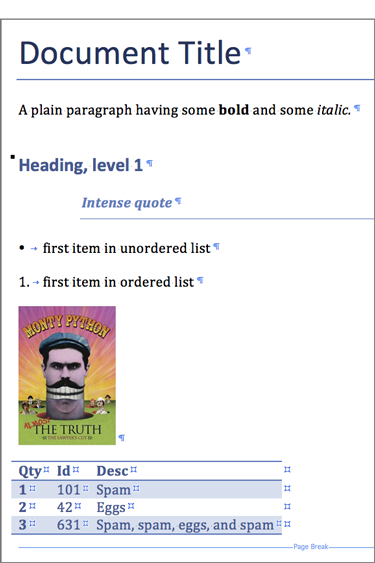Python Markdown Example
This makes Python system-independent and allows it to accommodate multiple single board computers, irrespective of the. In this example, we see how to. This page shows Python examples of telegram.InputTextMessageContent.
Summary¶
Example of Markdown. Markdown code Try it. MD view as HTML. HEX to Pantone Converter. Python Beautifier. R Markdown Python Engine. For example, the following code demonstrates reading and filtering a CSV file using Pandas then plotting the resulting data.
The Table of Contents extension generates a Table of Contents from a Markdowndocument and adds it into the resulting HTML document.
This extension is included in the standard Markdown library.
Syntax¶
By default, all headers will automatically have unique id attributesgenerated based upon the text of the header. Note this example, in which allthree headers would have the same id:
Results in:
Place a marker in the document where you would like the Table of Contents toappear. Then, a nested list of all the headers in the document will replace themarker. The marker defaults to [TOC] so the following document:
would generate the following output:
Regardless of whether a marker is found in the document (or disabled), theTable of Contents is available as an attribute (toc) on the Markdown class.This allows one to insert the Table of Contents elsewhere in their pagetemplate. For example:
The toc_tokens attribute is also available on the Markdown class and containsa nested list of dict objects. For example, the above document would result inthe following object at md.toc_tokens:
Note that the level refers to the hn level. In other words, <h1> is level1 and <h2> is level 2, etc. Be aware that improperly nested levels in theinput may result in odd nesting of the output.
Custom Labels¶
In most cases, the text label in the Table of Contents should match the text ofthe header. However, occasionally that is not desirable. In that case, if thisextension is used in conjunction with the Attribute Lists Extension and adata-toc-label attribute is defined on the header, then the contents of thatattribute will be used as the text label for the item in the Table of Contents.For example, the following Markdown:
would generate the following output:
Notice that the text in the Table of Contents is much cleaner and easier to readin the context of a Table of Contents. The data-toc-label is not included inthe HTML header element. Also note that the ID was manually defined in theattribute list to provide a cleaner URL when linking to the header. If the ID isnot manually defined, it is always derived from the text of the header, neverfrom the data-toc-label attribute.
Python Markdown Formatting
Usage¶
See Extensions for general extension usage. Use toc as the nameof the extension.
Markdown Example Code
See the Library Reference for information aboutconfiguring extensions.

The following options are provided to configure the output:
marker: Text to find and replace with the Table of Contents. Defaults to[TOC].Set to an empty string to disable searching for a marker, which may savesome time, especially on long documents.
title: Title to insert in the Table of Contents’<div>. Defaults toNone.anchorlink: Set toTrueto cause all headers to link to themselves. Default isFalse.anchorlink_class: CSS class(es) used for the link. Defaults totoclink.permalink: Set toTrueor a string to generate permanent links at the end of each header. Useful with Sphinx style sheets.When set to
Truethe paragraph symbol (¶ or “¶”) is used asthe link text. When set to a string, the provided string is used as the linktext.permalink_class: CSS class(es) used for the link. Defaults toheaderlink.permalink_title: Title attribute of the permanent link. Defaults toPermanent link.baselevel: Base level for headers. Defaults to1.The
baselevelsetting allows the header levels to be automaticallyadjusted to fit within the hierarchy of your HTML templates. For example,suppose the Markdown text for a page should not contain any headers higherthan level 3 (<h3>). The following will accomplish that:slugify: Callable to generate anchors.Default:
markdown.extensions.headerid.slugifyIn order to use a different algorithm to define the id attributes, define andpass in a callable which takes the following two arguments:
value: The string to slugify.separator: The Word Separator.
The callable must return a string appropriate for use in HTML
idattributes.An alternate version of the default callable supporting Unicode strings is alsoprovided as
markdown.extensions.headerid.slugify_unicode.separator: Word separator. Character which replaces white space in id. Defaults to “-”.toc_depthDefine the range of section levels to include in the Table of Contents. A single integer (b) defines the bottom section level (<h1>..<hb>) only. A string consisting of two digits separated by a hyphen in between ('2-5'), define the top (t) and the bottom (b) (<ht>..<hb>). Defaults to6(bottom).When used with conjunction with
baselevel, this parameter will nottake the fitted hierarchy frombaselevelinto account. That is, ifbothtoc_depthandbaselevelare3, then only the highest levelwill be present in the table. If you setbaselevelto3andtoc_depthto'2-6', the first headline will be<h3>and so stillincluded in the Table of Contents. To exclude this first level, youhave to settoc_depthto'4-6'.
A trivial example:
I'm currently looking at incorporating some more markdown functionality in a few personal Python centric projects I have. There is some interesting stuff in this space.
Sundown is a markdown parser for Python and many other languages. Specifically, Misaka is the Python implementation of Sundown.
Pyhame is a static html generator for markdown with support for code highlighting. Installation looks simple.
Ever2Simple is a Python module for migrataing Evernote documents to Simplenote with conversion to markdown. This looks very interesting.
Markdown Examples Python
Leaf is billed as a Python library for parsing HTML. But there is a nice feature to convert html to markdown.
